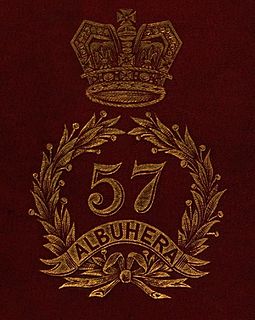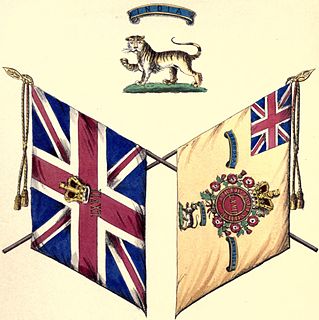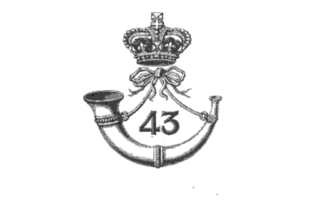Related Research Articles
The 47th (Lancashire) Regiment of Foot was an infantry regiment of the British Army, raised in Scotland in 1741. It served in North America during the Seven Years' War and American Revolutionary War and also fought during the Napoleonic Wars and the Crimean War. Under the Childers Reforms it amalgamated with the 81st Regiment of Foot to form the Loyal Regiment in 1881.

The Somerset Light Infantry was a light infantry regiment of the British Army, which served under various titles from 1685 to 1959. In 1959, the regiment was amalgamated with the Duke of Cornwall's Light Infantry to form the Somerset and Cornwall Light Infantry which was again amalgamated, in 1968, with the King's Own Yorkshire Light Infantry, the King's Shropshire Light Infantry and the Durham Light Infantry to form The Light Infantry. In 2007, however, The Light Infantry was amalgamated further with the Devonshire and Dorset Regiment, the Royal Gloucestershire, Berkshire and Wiltshire Regiment and the Royal Green Jackets to form The Rifles.

The 50th Regiment of Foot was an infantry regiment of the British Army, raised in 1755. Under the Childers Reforms it amalgamated with the 97th Regiment of Foot to form the Queen's Own Royal West Kent Regiment in 1881.

The 56th Regiment of Foot was an infantry regiment in the British Army, active from 1755 to 1881. It was originally raised in Northumbria as the 58th Regiment, and renumbered the 56th the following year when two senior regiments were disbanded. It saw service in Cuba at the capture of Havana in the Seven Years' War, and was later part of the garrison during the Great Siege of Gibraltar in the American Revolutionary War. During the French Revolutionary Wars it fought in the Caribbean and then in Holland. On the outbreak of the Napoleonic Wars the 56th raised a second battalion in 1804 as part of the anti-invasion preparations; both saw service in India and in the Indian Ocean, with the first capturing Réunion and Mauritius. A third battalion was formed in the later years of the war, but was disbanded after a brief period of service in the Netherlands.

The 55th Regiment of Foot was a British Army infantry regiment, raised in 1755. After 1782 it had a county designation added, becoming known as the 55th (Westmorland) Regiment of Foot. Under the Childers Reforms it amalgamated with the 34th (Cumberland) Regiment of Foot to form the Border Regiment in 1881.

The 57th Regiment of Foot was a regiment of line infantry in the British Army, raised in 1755. Under the Childers Reforms it amalgamated with the 77th Regiment of Foot to form the Middlesex Regiment in 1881.

The 67th Regiment of Foot was a line infantry regiment of the British Army, raised in 1756. Under the Childers Reforms it amalgamated with the 37th Regiment of Foot to form the Hampshire Regiment in 1881.
The 74th Regiment of Foot was an infantry regiment of the British Army from 1758 to 1763.

The 68th (Durham) Regiment of Foot was an infantry regiment of the British Army, raised in 1758. Under the Childers Reforms it amalgamated with the 106th Bombay Light Infantry to form the Durham Light Infantry in 1881, the 68th Regiment becoming the 1st Battalion, and the 106th Regiment becoming the 2nd Battalion in the regular Army. It saw action during the Seven Years' War before being converted to Light Infantry in 1808, fighting with distinction in the Peninsular Army under Arthur Wellesley. It would go on to fight with some distinction during the Crimean War, served during the Indian Mutiny and the New Zealand wars before returning to India between 1872 and 1888.
The 100th Regiment of Foot, also known as Campbell's Highlanders, was an infantry regiment of the British Army, formed in 1760 and disbanded in 1763.

The 43rd (Monmouthshire) Regiment of Foot was an infantry regiment of the British Army, raised in 1741. Under the Childers Reforms it amalgamated with the 52nd (Oxfordshire) Regiment of Foot to form the 1st and 2nd battalions of the Oxfordshire Light Infantry in 1881. The regiment went on to become the Oxfordshire and Buckinghamshire Light Infantry in 1908.
The 114th Regiment of Foot was an infantry regiment of the British Army from 1761 to 1763.It was raised in October 1761, by Sir Allan MacLean of Torloisk. He was commissioned lieutenant in the 60th Foot Royal Americans at the beginning of the Seven Years' War and was severely wounded at Ticonderoga in 1758. He was then given one of the four NY Independent Companies until he returned to Scotland where he raised the 114th Maclean's Highlanders, or the Royal Highland Volunteers, as their Major Commandant. The regiment was disbanded in 1763.

The 106th Regiment of Foot was an infantry regiment of the British Army from 1862 to 1881, the third to bear the number after the Black Musqueteers (1761–1763) and a regiment raised briefly in 1794. It was formed by renaming the 2nd Bombay European Regiment, formed by the Honourable East India Company in 1839. In 1881 the 106th Regiment was joined with the 68th (Durham) Regiment of Foot to form the Durham Light Infantry, as its second regular battalion.
The 109th Regiment of Foot was an infantry regiment of the British Army from 1761 to 1763.
The 51st Regiment of Foot was a British Army line infantry regiment, raised in 1755. Under the Childers Reforms it amalgamated with the 105th Regiment of Foot to form the King's Own Yorkshire Light Infantry in 1881.
The 62nd (Wiltshire) Regiment of Foot was an infantry regiment of the British Army, which was raised in 1756 and saw service through the eighteenth and nineteenth centuries. Under the Childers Reforms it amalgamated with the 99th (Lanarkshire) Regiment of Foot to form the Wiltshire Regiment in 1881.
The 85th Regiment of Foot was a British Army line infantry regiment, raised in 1793. Under the Childers Reforms it amalgamated with the 53rd (Shropshire) Regiment of Foot to form the King's Shropshire Light Infantry in 1881.
The 104th Regiment of Foot was a short-lived infantry regiment of the British Army active during the Seven Years' War.
The 90th Regiment of Foot was a short-lived infantry regiment in the British Army which was raised in Ireland as a light infantry corps in 1759, during the Seven Years' War with France.
104th Regiment of Foot was a regiment of the British Army. The regiment had its origins in the New Brunswick Regiment of Fencible Infantry, a unit of fencibles raised for the defence of the colony of New Brunswick in 1803. Recruits were drawn from across British North America, Scotland, Ireland and existing British Army units. The regiment was formally entered into the establishment in 1806 with a strength of around 650 enlisted men but grew to almost 1,100 by 1808. In 1810 the regiment's officers requested that it join the British Army as a regiment of foot. This request was granted on 13 September 1810 and the unit was renamed the 104th Regiment of Foot.
References
- ↑ "106th Foot Timeline". British Light Infantry Regiments. Archived from the original on 3 March 2014. Retrieved 2 March 2014.
- ↑ Pollock, Arthur William Alsager (1875). The United Service Magazine, Volume 137. H Coulburn. p. 437.
- 1 2 Vane, William Lyonel (1914). The Durham Light Infantry, the United Red and White Rose. Gale & Polden. p. 106.
- ↑ The Eclectic Magazine of Foreign Literature, Science, and Art, Volume 16. Leavitt, Trow, & Company. 1849. p. 168.